Loudoun Wildlife Conservancy’s Habitat Herald – Volume 23 Issue 2, Summer 2018
by Nan McCarry
Grass plants are all around us, yet we probably don’t give them much thought, except to notice that it’s once again time to mow the lawn. Grasses, the Poaceae, form one of the largest plant families, with over 11,000 species, and grassland biomes cover one-quarter of the earth. The grasses have had a long relationship with mankind and have provided us with many “ecosystem services” — things nature does for us for free. Many of our most important crops are grasses, but they provide a host of other benefits.
One reason we might not notice the grasses is that, though they are flowering plants, their flowers are small and inconspicuous. Grasses depend upon pollination by wind rather than insects as do many other flowering plants. Making a large and colorful flower takes energy that a plant won’t use if not necessary. Grass flowers are so small, with specialized terminology for the parts, that it can be very frustrating for anyone but an expert to try to identify a species, as Lauren Brown points out in Grasses: An Identification Guide. Brown’s book is an accessible way for the rest of us to start to distinguish one grass from another.
Another characteristic of grasses is that many are able to spread vegetatively by rhizomes (underground stems) or stolons (above-ground branches). Grass leaves consist of two parts: the long narrow blade and the sheath, which encloses the stem. The fruit (which we would call the seed or grain) is called a caryopsis. Grasses have fibrous roots that can grow 10 feet deep in some species, which allows them to adapt to drought conditions and also helps slow stormwater and build soil — a couple of their many valuable ecosystem services! When these roots die, they are decomposed by the soil food web, which adds organic matter to the soil.
Grasses take up silica from the soil and form phytoliths (mineral particles the size of a cell) from the silica. Silica is what glass is made of, so this is why grasses feel sharp if you run your hand up and down the blade. Phytoliths can remain in the soil long after the grasses are gone, and archaeologists use them to determine what grasses were growing in an area millions of years ago.
Current research suggests that the first grasses arose around 70 million years ago, toward the end of the Cretaceous period. That was a bit before the dinosaurs died out, and grass remains have been found in fossilized dinosaur dung! The first grasses grew in forests, and only later did extensive grasslands arise, when many species of grass became adapted to more open, arid habitats.
The rise of grasslands has long been thought to have influenced the evolution of grazing herbivores such as horses and cattle. The hypsodont teeth (tall teeth with extra enamel) of horses have adapted to take a lot of wear and tear from grass phytoliths and grit from the soil, and the four-chambered stomach of cattle is efficient at digesting grasses.
Like grazing mammals, humans have a long history with the evolution of grasses. The Poaceae have provided mankind with more domesticated food crops than any other family. Domesticated plants are ones that have become adapted to being reproduced by humans to the point that they are genetically different from their wild ancestors. Domestication is a subset of the process of natural selection, with humans doing the selecting and unconsciously affecting natural selection, by simply choosing to grow the most desirable plants from an available population.
Wheat (Triticum spp.) and barley (Hordeum vulgare), thought to be the first domesticated crops, were domesticated in the Near East around 12,000 years ago. Other important domesticated grasses include rice (Oryza sativa), sorghum (Sorghum bicolor), corn (Zea mays) and sugarcane (Saccharum officinarum).
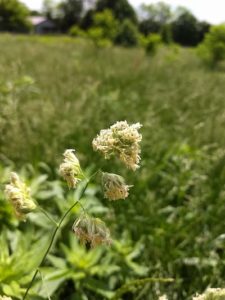
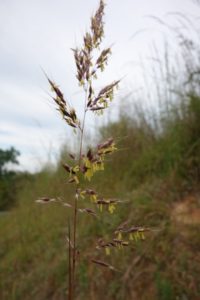
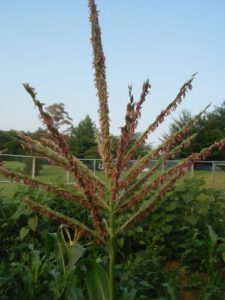
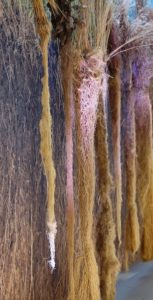
Many grasses easily colonize open, disturbed areas, and some domesticated grass crops first evolved as weeds in farmers’ fields. Rye (Secale cereale) and oats (Avena sativa) were domesticated in this way. Weeds and crops are in fact closely related: both “follow” humans around, taking advantage of the disturbed areas and open habitats that we create. Grasses we value became domesticated crops, and the ones we don’t mostly became identified as weeds. Some weedy grasses were actually considered valuable economic plants in the past. For example, crabgrass (Digitaria sanguinalis) was cultivated in Europe for food in the 1800s.
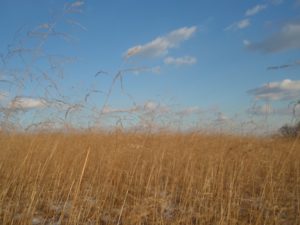
Broomsedge
Photo by Nan McCarry
Another way the Poaceae figure in human history is through the forage grasses that livestock depend upon. Many grasses can be grazed repeatedly because they regrow from a point near the base of the leaf or shoot, where in most plants new growth occurs at the apices or tips. When English colonists brought livestock to the colonies, some of the existing indigenous grasses could not withstand the grazing pressure, so the colonists imported Old World forage grasses, which were more adapted to continual grazing. Some of those imports were so successful that we may think of them as native to the Americas. For example, Kentucky bluegrass (Poa pratensis) was brought to the New World by the English, but spread so quickly that settlers found it growing in Kentucky by the time they arrived. Kentucky bluegrass is only one of many of our turf grasses that evolved to be adapted to herbivore grazing — and therefore ultimately pre-adapted to our lawn mowers.
Wildlife enthusiasts are now trying to bring back native grasses. Grassland birds, such as the Eastern Meadowlark, the Grasshopper Sparrow, the Bobolink, and the Bob-white Quail, forage and nest on the ground in the spaces between bunched and upright grasses. Some non-native grasses, especially tall fescue (Schedonorus arundinaceus), form mats right down to the ground, which means the birds have no place to safely nest and forage.
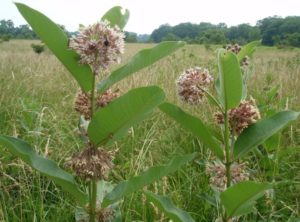
Meadow milkweed
Photo by Nan McCarry
Many homeowners and landowners have contributed to the effort to support birds and other wildlife by establishing meadows. Anyone with a small property can start with a “pocket meadow,” or a pollinator garden with both grasses and wildflowers, which is easier to manage than a larger meadow, and expand from there. These provide habitat for pollinators and birds, shade the soil during our hot summers, and allow water to seep into the soil—all things our lawns don’t do very well.
Some of the native grasses that make up meadows look lovely massed in the home landscape. Ann Garvey, who started Loudoun Wildlife’s chapter of Audubon at Home, says that Purple Lovegrass (Eragrostis spectabilis) is great for dry, hot, sunny spots, and is “just a big mound of purplish joy” in the fall. Purple Lovegrass is the host plant for the caterpillar of the Zabulon Skipper butterfly.
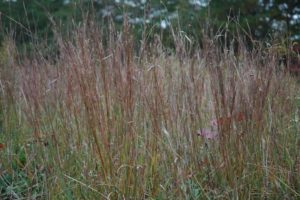
Little Bluestem
Photo by Janet Davis
Little Bluestem (Schizachyrium scoparium) is a favorite of Janet Davis, owner of Hill House Nursery. It provides both seeds and nesting sites for grassland birds in winter.
Switchgrass (Panicum virgatum) is a “workhorse in any garden,” according to landscape designer John Magee of Magee Design. Switchgrass has deep roots, so it can hold soil in place and filter water. Janet Davis likes the Switchgrass cultivar “Shenandoah” because it is smaller and has outstanding color. Switchgrass is a host for several caterpillars, and many birds eat its seeds. It remains upright during the winter, providing cover for wildlife.
A grass you may see growing in unmown fields is Broomsedge (Andropogon virginicus). It’s aggressive, but John Magee says that’s an excellent quality in order to outcompete introduced invasive species. “It has the best winter interest of any of our grasses, especially when planted with a backdrop of evergreen hollies, or cedars,” he notes.
An unassuming grass that Celia Vuocolo, Habitat and Stewardship Coordinator of Piedmont Environmental Council, likes is Poverty Oatgrass (Danthonia spicata), because “it can handle almost every condition — dry shade to rocky sunny areas and where not much else wants to grow.” It supports the caterpillars of native skipper butterflies like Leonard’s Skipper and Indian Skipper.
Bringing native grasses into our home landscapes allows us to benefit wildlife as well as gain a new appreciation for our ancient benefactors, the overlooked Poaceae.